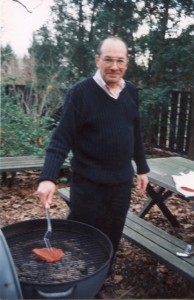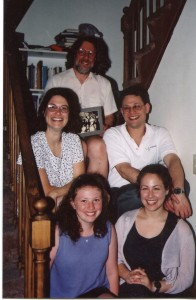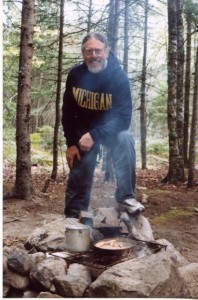There is a lot that could be said about this week’s portion. We could talk about Korach’s rebellion. We could talk about leadership and how leaders handle differences of opinion. We could talk about whether this portion is a model for pluralism—the same pluralism we embrace here and which both the Israel Religious Action Center of the Reform Movement and Rav Kook seem to point towards. We could talk about whether the punishment was just. We could talk about how for the last three weeks we have been told in each Torah portion why speaking ill is bad—Miriam, the spies and now Korach. But we are not going to.
I want to talk about just this one verse.
“And he stood between the dead and the living. And the plague was stayed.” Numbers 17:13
Look at it closely. What does it mean? Who is the he? Put it in a context? Now what it is it talking about?
Rashi helps us understand:
He stood between the dead…: He took hold of the angel and held him against his will. The angel said to him, “Allow me to accomplish my mission.” He [Aaron] said to him, “Moses commanded me to stop you.” He said to him, “I am the messenger of the Omnipresent, and you are the messenger of Moses.” He said to him, “Moses does not say anything on his own volition, but only at the bidding of the Almighty. If you do not believe [me], the Holy One, blessed is He, and Moses are at the entrance of the Tent of Meeting; come with me and ask.” This is the meaning of the statement, “Aaron returned to Moses” (Mid. Tanchuma Tetzaveh 15). Another interpretation: Why with incense? Because the Israelites were slandering and vilifying the incense, saying that it was a deadly poison; through it Nadab and Abihu died; through it two hundred and fifty people were burnt. The Holy One, blessed is He, said, “You shall see that it will stop the plague, and it is sin that caused their death.” – [Mid. Aggadah. See Mechilta Beshallach (Vayassa 6:5, Ber. 33a]
What does it mean to stand between the dead and the living?
Aaron, a high priest who is not supposed to come in contact with the dead, does it anyway. Why? As someone pointed out because sometimes there is an obligation that supersedes the rules. This is one of those times. He stands up and the plague stops. He stands up and is counted.
Who does that today? Doctors, nurses, those compassionate care teams that I have been witnessing and praising. Rabbis, sometimes, and when we do it is a privilege. We witness something important. We stand between life and death.
What if there are not people who are willing to stand between the living and the dead?
In this country, we take access to medical care for granted. And in truth we are lucky.
American Jewish World Service’s weekly D’var Tzedek talks about this verse and points out that in Africa there is a severe shortage of doctors. Citing the World Health Organization, they said, “The World Health Organization estimated in 2006 that one in four African-trained doctors leaves the continent for work in wealthier regions, with the workforce shortage believed to only have worsened since then.5 In Sierra Leone, a country of over 5 million people, there are only 75 state medical doctors and 25 medical specialists; and in Liberia, population 3.5 million, there are a total of 122 doctors. In Malawi, there are two doctors and 56 nurses for every 100,000 people; in Mozambique the ratio is three doctors and 20 nurses per 100,000.6 By contrast, in those wealthier countries comprising the Organization for Economic Cooperation and Development (OECD), there are, on average, about 310 doctors for every 100,000 people.”
Those are scary numbers. In truth, independent of these statistics, health care, or the lack of it, was part of why I decided going to Kenya this summer was not right for me. I’ll discuss more of that later.
I think, however, what this verse is pointing towards something even more important. How we handle liminal time.
What is liminal time?
- It is that time in between.
- It is a time of transition:
- Between spring and summer, like today
- Between daytime and night time—as we watched last night, or as we watch waiting for Shabbat to end.
- Between jobs, between houses, between school
- Between public space and private space
- Between applying for college and being accepted.
- Or as this very verse suggests, between life and death
I, for one, love to sit on a certain section of Lake Michigan beach and watch the sunset, preferably with a glass of wine and some smoked whitefish. In our electric light world, we rarely take the time to notice the subtle gradations of light. There is something about sitting at the beach that makes it possible. Maybe the expanse of sky and water. Maybe the intentionality of it, the kavanah of really watching, of taking the time.
But liminal time isn’t always easy. Why is liminal time hard? How do we mark liminal time?
Liminal time is hard because we get anxious. Change is hard. We are going into the unknown and that scares us. We mark these times with rituals. If you were an ancient you might build Stonehenge to mark the Summer Solstice.
Judaism marks liminal time:
- Mezuzah to mark the space between public and private, right on that doorpost to remind us of who we are every time we go in or out of our houses .
- Kiddush to mark the beginning of Shabbat and Havadalah to mark the end.
- Kaddish to mark the transitions between parts of the service.
- Bar Mitzvah to mark the transition between being a child and being an adult.
- Yom Kippur to mark being forgiven and starting the new year renewed, cleansed
- Mikveh to mark time—between being ritually not ready, and ritually ready, between being niddah and being tahara, between being not Jewish and being Jewish. When you go into the mikveh, you come out changed in some way.
Dr. Erica Brown spoke about liminality at the National Mikveh Conference. Yes, there is one! She said, “What we’ve identified are space, time, and milestone events which are actually transitions,” Brown says, and she notes that all religions are intrigued by transitional times, which produce anxieties; we place rituals in those moments for that reason. We’ve just come to the same conclusions!
What are some of those anxieties and why do rituals help?
- Bedtime rituals: reading a story to a young child, saying Sh’ma, settling down in some way, that last glass of water (or wine)
- Birthday rituals: candles, cake, making a wish, presents
- The tooth fairy
What about death? What about standing between life and death?
Even before death, if we are lucky and we take the time to think about it, we have prepared. We might have written an ethical will. I hope you each have a living will, an advanced directive, a power of attorney. I hope you have told your own families what you want to have happen once you die.
We Jews are good at death. We have lots of rituals for marking this liminal time of grief:
- Saying Sh’ma and Baruch Dayan HaEmet
- Organizing the community to support the family, to bring food and attend the funeral and shiva.
- Burying quickly
- Tearing a garment and throwing dirt on the grave
- Washing your hands after returning from the cemetery
- Lighting a candle
- Sitting on low stools, covering mirrors
- Eating an egg, symbol of life
- Reciting Kaddish, praising G-d for life
We mark time differently from the first intense 7 days, then the first thirty days and the first year.
Rituals help us experience these transitions in a powerful way. They force us to pay attention to the subtle gradations of how our experience changes over time.
We experience these transitions in a powerful way anyway; the rituals force us to pay attention to the subtle gradations of how our experience changes over time. The rituals allow us to experience what we experience within certain structures. They enact transformation and provide us with a cushion between times.
And they allow us, even in our insecurities and uncertainties to know that we are part of something bigger something greater than ourselves. That there is order in the chaos. That there is a wider community. That there is G-d. And this brings us hope.
Rituals connect us not only horizontally (to friends and family members who are celebrating with us, wherever we are) but also vertically (to people who came before us and people who will come after us and to G-d.)
The intentionality, the kavanah is important. It allows our multi-tasking brains to slow down enough to be present in the moment. To feel. To feel G-d’s presence. To bring G-d into the pause, as Erica Brown said. But you can’t wait for that perfect moment of inspiration (remember inspiration comes from the word for breath too!). If you wait for perfect inspiration and intention, you will never write a book!
It is not always possible to achieve great kavanah. Sometimes prayer connects us to G-d and sometimes to our kids, our family, our community and that can be enough. It is the difference between keva and kavanah. Structure and intention. Abraham Joshua Heschel talked about the need for keva to support the days when he didn’t have the kavanah.
Blu Greenberg says it this way in How to Run a Traditional Jewish Household:
But how, the reader might ask, can one perform ritual without perfect and pure intent? Is it not a sham? The answer might be, ‘Once more, with feeling.’ Even so, should ritual or rite happen to be devoid of inner spirit at any given moment, it does not mean that it is devoid of meaning. Sometimes, in ritual, we simply feel part of the community, and that is enough. Sometimes, ritual serves to generate a sense of self, and that is enough. Sometimes it strengthens the family unit, and that is enough. And sometimes, it connects us to the Divine, and that is enough.
If we sit in a sukkah and don’t experience joy, it is enough.
If we light Shabbat candles and we don’t direct our hearts to making Shabbat, it is enough.
This is true for almost all Jewish rituals.
But there are two rituals that if we do them without kavanah, they don’t count. Saying Sh’ma and mikveh. Because both are about being present in the moment.
Later in the text we will read the word Hiney. It means Behold, or Here. It is a marker that something important is about to happen. Brown understands it as “I am fully present.”
The Hebrew word “hineni” means “I am here.” Brown understands it as “I am fully present” This is hard to do, in this age of technology. I swear I heard someone’s cell phone beep since I started this discussion. Are each of you fully present to this moment?
Being right here. Right now. That is the function of a ritual.
Not just because we have to, because it is an obligation, because it is a commandment, because G-d said to. It was never very effective when as parents our children said, why do we have to do something and we answered, “Because I said so.”
Rituals help us mark liminal time. They help us manage change. They allow us to wrestle with our anxieties and uncertainties. They enable us to be like Aaron, to stand between the living and the dead.


